The journey to discover the most beautiful art cities in Italy continues, Pronti Partenza Via this time takes you to one of Lombardy’s capital cities, and if you have the patience to watch the episode and read the article, you may discover a city rich in history and tradition: here is Cremona.
The city is little known from tourist itineraries, in favor of its neighboring Lombard sister Mantova or of the Emilian Parma. They have in common a territory marked by the passage of the great river Po, thanks to which they were born and developed. In Cremona there is even a river port to emphasize the importance of this trade route. Cremona, if you please, is also the provincial capital of my homeland, so forgive me if I emphasize the merits of my Po Valley.
The city of Cremona also had a very important historical role precisely because it controlled trade with the Adriatic and was at the center of territorial struggles, claiming (as a free commune) its own independence until it was conquered by the Visconti in the 14th century. It was then a protagonist in the wars between the Duchy of Milan and the Republic of Venice, the latter having the upper hand and the city being conquered by the Serenissima.
The medieval epoch left the greatest architectural traces in the city, the main buildings being precisely the ancient Palace of the Guelphs of Cittanova and the Palace of the Ghibellines (or Nobles) present-day Town Hall. The latter faces with its crenellated front onto Cremona’s main square where political and religious power meet. To the side of the Town Hall is the thirteenth-century Loggia dei Militi, while opposite stands the majestic front of the Duomo flanked by the very tall brick bell tower on the left and the Baptistery on the right.
 |
| The Town Hall and the Loggia dei Militi |
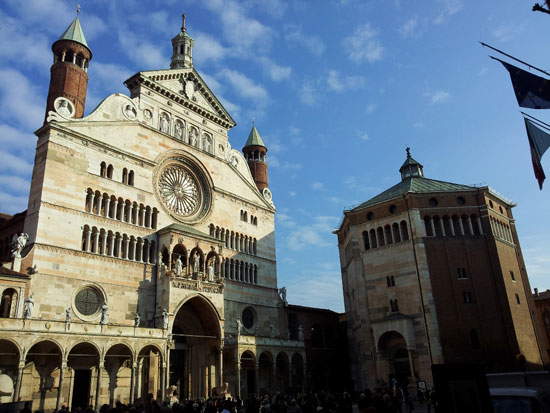 |
| The Duomo and Baptistery |
The Duomo and Baptistery present a mixture of styles; born with a Romanesque layout (construction dates back to the 12th century), the Cathedral was later enlarged with two transepts (longer than the main nave) between the 13th and 14th centuries and provided with two true side facades. The main front, on the other hand, was covered in marble during the Renaissance period, with the construction of the Loggia della Bertazzola that connects it to the bell tower. The Torrazzo is the tallest brick bell tower in Europe (111 meters) and on it is the 16th-century astronomical clock.The Renaissance saw the birth of an important Cremonese school of painting that found application in numerous paintings that still adorn Cremonese churches and palaces.
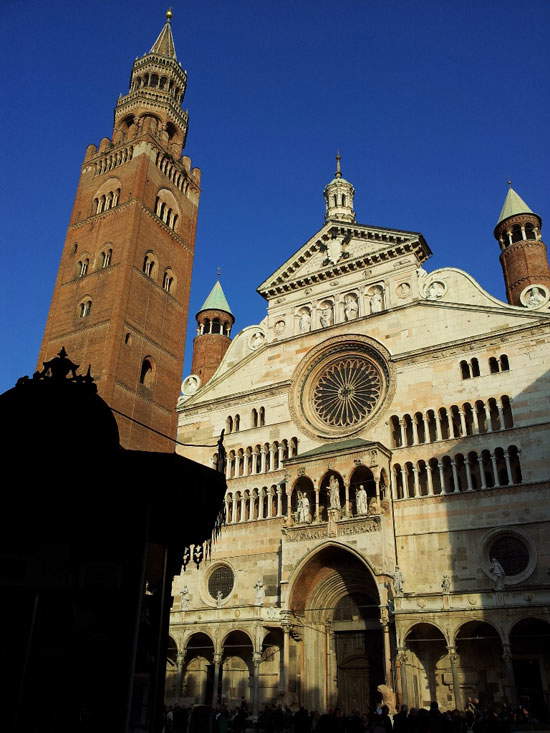 |
| The Duomo and the Torrazzo |
Cremona undoubtedly is world-famous for another art, which is its crowning achievement and which has earned it the prestigious UNESCO recognition: violin making, that is, the craftsmanship of making violins. It was Andrea Amati in the mid-sixteenth century who was the progenitor of this fruitful family of violin makers, which includes among its other masters the Guarneri del Gesù and the better known Antonio Stradivari, who was born in Cremona in 1643 and opened his own violin-making workshop in the city, building the most famous, valuable and renowned violins in the world.
To this day, the luthier’s art still brings the city to life with a hundred workshops, the International Violinmaking School and the Violin Museum (recently relocated to a renovated location that brings together all the collections previously scattered around the city). Certainly for those visiting Cremona, a stop at this extraordinary museum is not to be missed, where one can attend auditions during which the historic violins on display are played periodically.
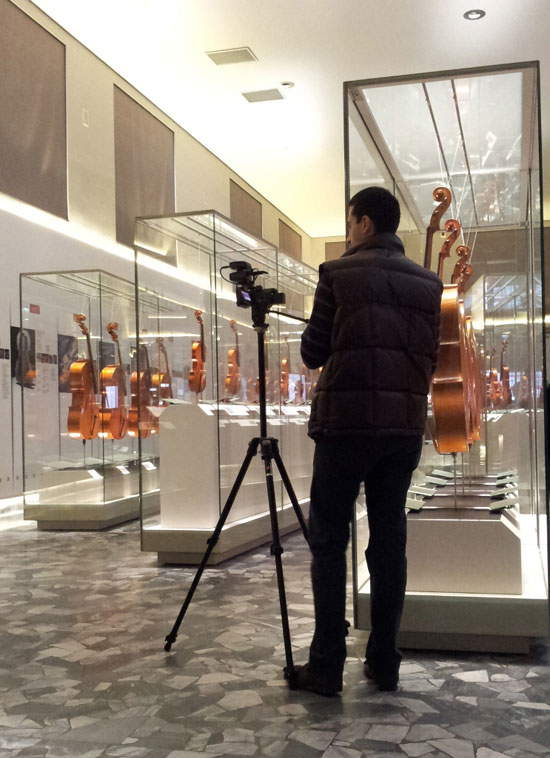 |
| Fabrizio at the Violin Museum in Cremona |
And so it is that the violin has become one of the prestigious symbols of the city, which can only be joined by the architectural symbol, the aforementioned Torrazzo. The latter is not only an architectural emblem but also a gastronomic one, well I will let you in on a secret (which is not so much of a secret after all). Have you ever eaten a stick of nougat? Have you ever wondered why that name and shape? It all originated here in Cremona on the occasion of Bianca Maria Visconti’s wedding to Francesco Sforza, in their honor the local pastry chefs created a sweet made of roasted almonds: they gave it a shape and a name that would remind them of their beloved Torrazzo, thus Torrone was born.
It is precisely said, that Cremona is the city of the 3Ts: turòn (nougat), turas (torrazzo) and tetas (tettone), I cannot explain instead the origin of the name about the prosperity of Cremonese women, if anyone knows about it is invited to illustrate it to us.
Returning to nougat, a typical sweet in Cremona’s confectionery tradition, it is celebrated and celebrated in November with events, markets, stands, stalls and shows during the Nougat Festival, which this year takes place on November 21-22 and 28-29, exceptionally preceded by two events in October (to coincide with Expo) in which the wedding and procession from Milan to Cremona of Bianca Maria and Francesco from which this whole sweet story was born.
You are all invited to this celebration, maybe we will cincontreras on the streets of my beautiful Cremona. To conclude I would like to ask you just one question this time, I would like you to try to answer it, it is simple. Besides the already mentioned Master Violin Makers would you know the names of at least 3 other famous people born in Cremona? Bye, have a good trip and enjoy!
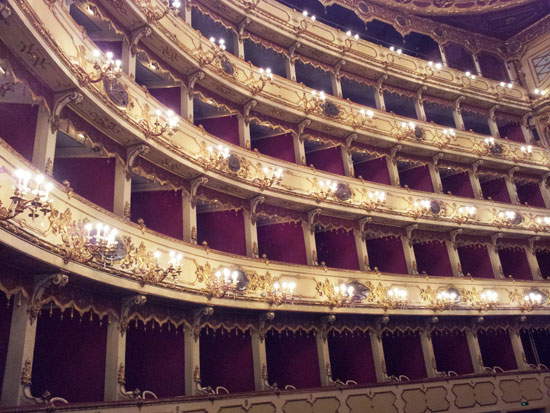 |
| The Ponchielli Theater |
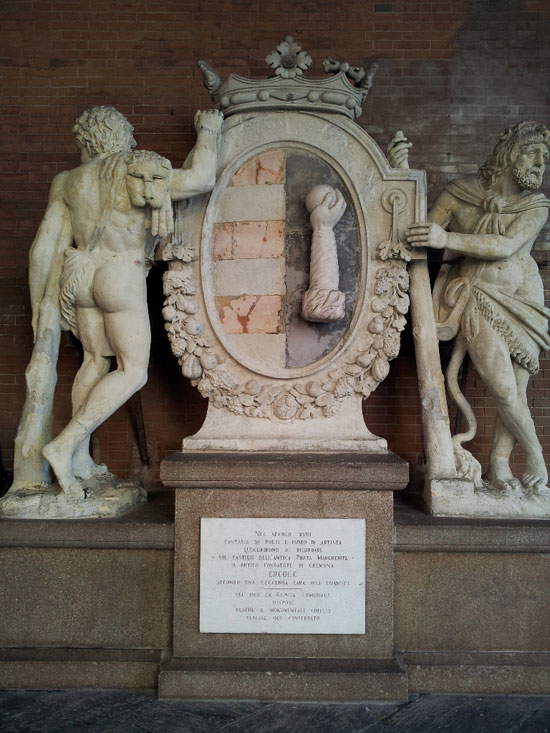 |
| The municipal coat of arms of Cremona under the Loggia dei Militi |
Warning: the translation into English of the original Italian article was created using automatic tools. We undertake to review all articles, but we do not guarantee the total absence of inaccuracies in the translation due to the program. You can find the original by clicking on the ITA button. If you find any mistake,please contact us.